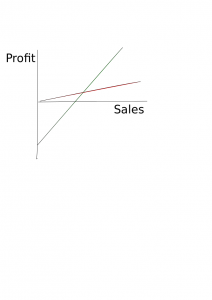Lean thinking is particularly well-suited to today’s battle of margins in a weak economic environment because it comes from Toyota’s innovations in post-war market, where demand for cars was occasional, sparse, intermittent and difficult to predict.
Customer Driven
In customer driven business model it is important to sell what the customers need and reserve production assets just after the customer’s order. Sales and marketing should emphasize customers more. That sells better than pushing what we happen to offer. Listening to customers is an important way to find tacit signals necessary for developing the products. We can meet the needs by preferring simple and fast solutions and avoid the tendency to invest heavily and slowly. Consultation business can begin lightly without extensive materials and finalized products. Consultants learn by doing, working together with the customers.Sales should not be overly concerned about the availability of the experts and resources. There are always more quotations than deals. Reservations should not be done before the commitments are clear. Transparency helps everyone to adapt to rapidly changing situation in available consultants and speculations and realizations of the deals.
Flexibility levels loads
The ideal situation in which the company acquires the resources only when needed is not possible. Prices are higher if you cherry-pick. Transaction and purchasing costs must be accounted and availability of the resources in peak demand is not a sure thing.

Impact of fixed costs to profits
Profit calculation is more difficult when the equation includes fixed costs. Annual rent of a typical agile team room could be 10 000 €. The charge for the corresponding space in Technopolis is 400 € per day. If the rented space would be used 10 days a year, it would cost € 1 000 a day. If we could use it 100 days a year, it would cost € 100 per day. It would save a lot if the same space could be used as the office space for the team, internal meeting room and meeting room for the customers. You have to invent how to profitably change the configuration of the space to fit the needs of the moment. It is probably cheaper than having separate rooms for each purpose or renting more space each time.Businesses are crazy about premises in Finland. They have always too much space and in too costly locations. Home offices have a clear competitive advantage.The situation is the same if we look at the profitability of the sales. If the profit of a consulting day after variable costs like accommodation, travel and the consultant’s fees and the avalanche of the general expenses is € 200 to cover the seller’s costs, each salesman must sell 500 days a year to reach € 100 000 gross margin paying a typical 5 000 € monthly salary for him. If sales are lower keeping the margin by increasing the selling price makes it more difficult to sell in a tense competition situation. ICT professionals have full-time employments because getting good people in bad terms is not possible. There is a long learning curve for each task and there is no visible end of the demand of their skills. Vendors’ success factor is a small cross-functional team in which all members are able to do virtually any of the tasks in the backlog. In addition, the team members could be responsible for a product development, support, sales support and marketing (especially brochures, blogs and public appearances). This ensures useful work throughout the year despite of the typical seasonality.If an organization is heavily based on specialized roles in its business model the weakness in demand is immediately reflected in the bottom line. It can not guarantee adequate income to its partner network and which fades away focusing on other customers.
Flat organization
Lean organization does not require a strongly specialized and multi-tiered hierarchy of managers because teams will make virtually all operational decisions. Maintaining and calculating profit margins is easy because organization’s general expenses are not significant. To get any work done creates a huge amount of coordination work if every task has its own manager. It is a slow and expensive. Trade of squirrel skins, purely speculative budgeting, performance management, etc. will add operations its own heavy share in the bottom line.Economic monitoring is simple. Lean measures throughput times in addition to sales and gross margins.
